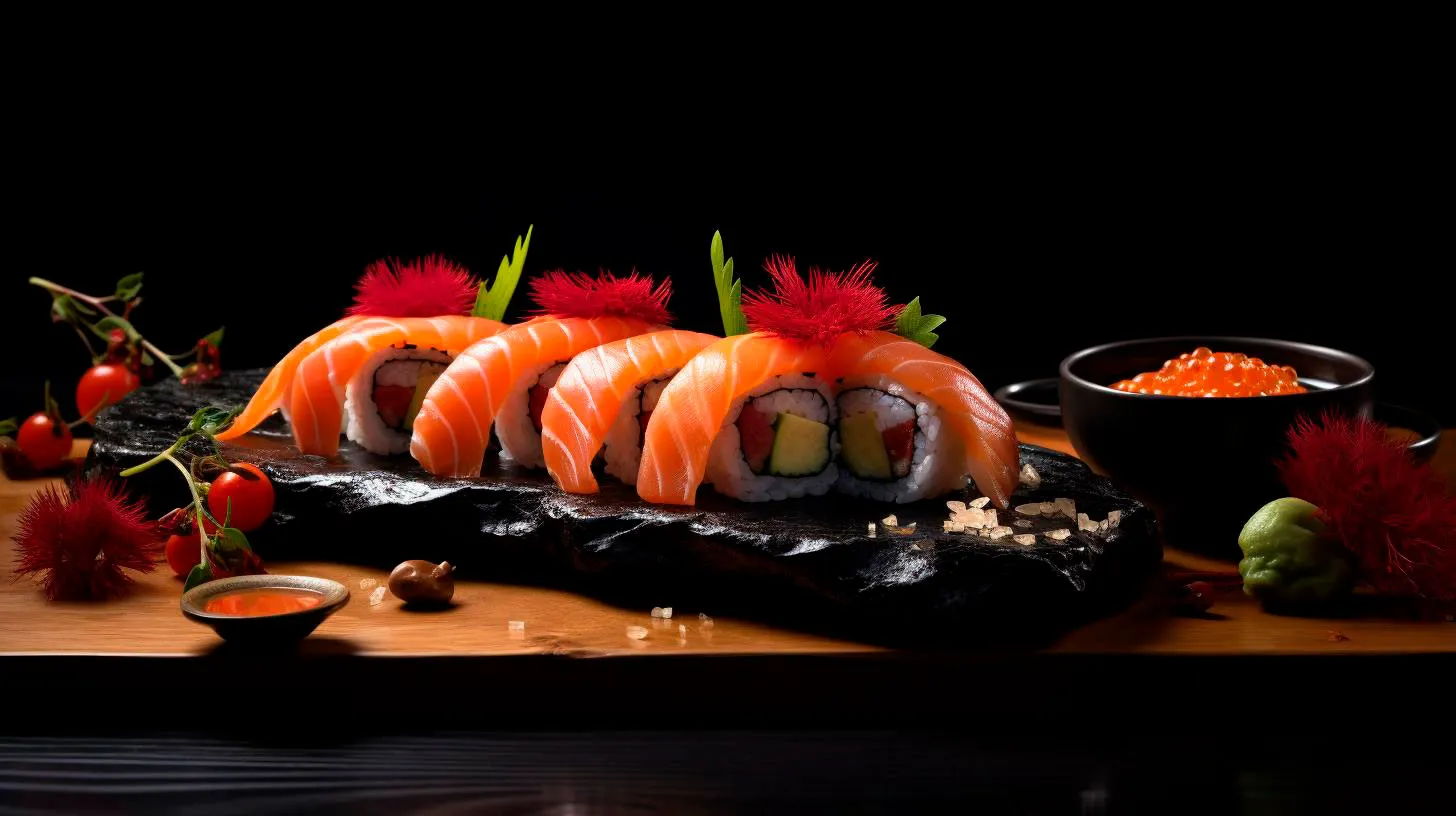The Science Behind Sushi Tasting
In this article, we will delve into the intricate details of the science behind sushi tasting.
The Umami Factor
One of the key elements that make sushi so irresistible is its umami flavor. Umami is the fifth basic taste that complements the traditional four tastes of sweet, sour, bitter, and salty. It is often described as a savory or meaty taste that can greatly enhance the overall flavor profile of a dish.
In sushi, umami is derived from ingredients like fish, seaweed, soy sauce, and fermented products. These ingredients contain glutamic acid and nucleotides, which stimulate taste receptors on our tongues, creating the sought-after umami taste. When combined with other flavors like sweet, salty, or tangy, umami amplifies the sensory experience and leaves a lasting impression.
- Umami is the fifth basic taste that adds savoriness to sushi.
- Ingredients like fish, seaweed, and soy sauce contribute to the umami flavor.
The Role of Rice
While fresh fish often steals the spotlight, the role of sushi rice should not be underestimated. The preparation of sushi rice is an art in itself. It requires specific vinegar, the right balance of moisture, and proper seasoning techniques.
One of the important functions of sushi rice is to balance the flavors of the entire sushi roll. The slightly acidic taste of rice vinegar serves as an excellent contrast to the rich umami flavor of fish. Additionally, the stickiness of the rice helps to bind the ingredients together, creating a cohesive and enjoyable eating experience.
- Sushi rice balances the flavors of the sushi roll.
- The acidity of rice vinegar complements the umami flavor of fish.
- The stickiness of the rice enhances the eating experience.
The Art of Texture
Texture plays a crucial role in how we perceive taste. In sushi, a variety of textures are deliberately combined to create a harmonious and engaging mouthfeel. From the softness of fish to the crunchiness of vegetables, each component adds depth and dimension to the overall taste experience.
For example, the contrast between smooth, melt-in-your-mouth raw fish and the slightly firm texture of the rice creates an interesting interplay of sensations. Additionally, the addition of crispy tempura or creamy avocado can introduce layers of textures, making every bite a delight.
- Texture enhances the overall taste experience of sushi.
- Combining soft and crunchy elements creates an interplay of sensations.
The Science of Presentation
Although taste is often the primary focus, the visual presentation of sushi is equally important. Our brains are wired to perceive food based on visual cues, and sushi chefs understand this well. The colorful and artistic arrangement of sushi pieces can greatly influence our perception of taste even before we take the first bite.
Moreover, the size and shape of each sushi roll impact the way flavors are distributed in our mouths. Sushi chefs take into consideration the mouth’s anatomy to ensure that the flavors are evenly spread across the palate, allowing us to fully appreciate the taste.
- The visual presentation of sushi impacts our perception of taste.
- The size and shape of sushi rolls affect flavor distribution in the mouth.
Key Takeaways
Sushi tasting is not simply about consuming raw fish and rice. It involves a careful fusion of flavors, textures, and presentation to create a sensory experience that delights our taste buds. Understanding the science behind sushi tasting can give us a newfound appreciation for this exquisite cuisine.
To summarize:
- Umami adds a savory element to sushi, enhancing its taste profile.
- Sushi rice balances flavors, thanks to its acidic nature and stickiness.
- The texture of sushi ingredients provides depth and engagement.
- The visual presentation of sushi impacts our perception of taste.
So, the next time you indulge in a plate of sushi, take a moment to savor the intricate flavors, textures, and aesthetics that make it such a delightful culinary experience.
Unlocking the Culinary Science of Sushi Taste Experiences
In this article, we will delve into the fascinating world of sushi and uncover the secrets behind its delectable taste.
The Art of Sushi Making
Sushi is more than just a dish; it is an art form that requires precision, skill, and an understanding of the science behind taste. Here are some key elements that contribute to the incredible taste experiences of sushi:
- Freshness: One of the most crucial aspects of sushi is the freshness of the ingredients, particularly the fish. Sushi chefs take great care in selecting the highest quality fish, ensuring that it is caught and prepared to perfection. Fresh fish not only enhances the flavor but also ensures food safety.
- Umami: Known as the fifth taste, umami is a savory flavor that adds depth and richness to dishes. Sushi ingredients like soy sauce, seaweed, and fish roe are packed with umami, creating a truly mouthwatering experience.
- Rice Preparation: Sushi rice plays a crucial role in the taste of sushi. Chefs follow a precise process of washing, cooking, and seasoning the rice with vinegar to create the perfect texture and flavor. The rice should be slightly sticky, allowing it to hold together when formed into sushi rolls.
- Balance of Flavors: Sushi is all about balance. From the sweetness of mirin in the rice to the tanginess of vinegar and the saltiness of soy sauce, each ingredient is carefully balanced to create a harmonious taste.
Flavor Pairings and Combinations
An important aspect of sushi taste experiences is the meticulous pairing and combining of flavors. Sushi chefs have mastered the art of creating perfect combinations that tantalize the taste buds. Some key flavor pairings and combinations include:
- Fatty Fish with Acidic Ingredients: Fatty fish like salmon or tuna pairs beautifully with ingredients like pickled ginger or citrusy ponzu sauce. The acidity cuts through the richness of the fish, creating a perfect balance of flavors.
- Creamy and Crunchy Textures: Sushi rolls often combine creamy elements like avocado or mayonnaise with crunchy ingredients like tempura flakes or cucumber. This contrast in texture adds dimension to the taste experience.
- Salty and Sweet: The juxtaposition of salty and sweet flavors is a common theme in sushi. Soy sauce, with its saltiness, complements the natural sweetness of seafood, creating a delightful combination.
The Role of Presentation
Aside from taste, presentation plays a significant role in the overall sushi experience. Sushi chefs take great care in arranging the ingredients, using vibrant colors and artistic techniques to enhance the visual appeal. A beautifully presented plate of sushi not only whets the appetite but also sets the stage for a memorable taste experience.
Key Takeaways
- The taste experiences of sushi are backed by the culinary science of freshness, umami, rice preparation, and flavor balance.
- Freshness of ingredients, especially fish, is crucial for both taste and food safety.
- Umami-rich ingredients like soy sauce and seaweed add depth and richness to sushi.
- The balance of flavors, including the sweetness of mirin, tanginess of vinegar, and saltiness of soy sauce, creates harmony in sushi taste experiences.
- Flavor pairings and combinations of ingredients, such as fatty fish with acidic elements and creamy textures with crunchy elements, add complexity to the taste.
- The presentation of sushi, with its artistic arrangement and vibrant colors, enhances the overall experience.
In conclusion, sushi is not only a culinary delight but also a fascinating study of taste experiences. Its intricate flavors, careful pairing of ingredients, and meticulous presentation all contribute to the extraordinary culinary journey that sushi offers. So, the next time you savor a piece of sushi, take a moment to appreciate the culinary science behind its perfect taste.
Unveiling the Secrets of Discerning Flavors in Sushi
In this article, we will unravel the secrets of discerning flavors in sushi and elevate your sushi appreciation game to new heights!
The Art of Sushi Tasting
When it comes to tasting sushi, it is essential to engage all your senses. A well-prepared sushi roll should be visually appealing, aromatic, and have a complex range of flavors. Follow these steps to enhance your sushi tasting experience:
- Visual Assessment: Begin by carefully observing the presentation of the sushi roll. Pay attention to the color, arrangement, and freshness of the ingredients. Aesthetically pleasing sushi is usually an indication of both quality and flavor.
- Aromas and Fragrances: Before taking a bite, bring your sushi closer to your nose and inhale gently. The aromas from the fish, rice, and condiments will give you an initial hint of the flavors to come.
- Chewing Technique: When you take a bite, ensure you chew the sushi slowly and evenly to allow the flavors to develop. Be mindful of the textures of different ingredients, such as the smoothness of the fish or the crunchiness of vegetables or tempura.
Key Flavor Components in Sushi
To discern the flavors in sushi, it is crucial to understand the key ingredients and combinations that contribute to its taste profile. Here are some essential flavor components found in sushi:
1. Fish Varieties:
The type of fish used plays a significant role in determining the taste of sushi. From delicate white fish like fluke to rich fatty fish like salmon, each variety offers a distinct flavor and texture. Understanding the characteristics of different fish species will help you appreciate and differentiate flavors.
2. Rice Preparation:
Rice serves as the foundation of sushi. It is seasoned with vinegar, salt, and sugar, giving it a slightly tangy flavor. The quality of rice, its stickiness, and the perfect balance of seasoning are crucial for a well-executed sushi roll.
3. Condiments and Toppings:
The addition of condiments such as soy sauce, wasabi, pickled ginger, and toppings like tobiko (flying fish roe) or sesame seeds further enhances the flavors in sushi. Each of these elements adds its unique taste and texture that complements the rest of the ingredients.
Training Your Palate
Just like any other skill, developing a discerning palate for sushi flavors requires practice and exploration. Here are some tips to help you train your palate:
- Try Different Varieties: Experiment with various types of sushi rolls, from traditional nigiri to creative maki rolls. This will expose your taste buds to a range of flavor combinations and textures.
- Take Note of Flavor Profiles: Reflect on the flavors you enjoy the most. Is it the delicate sweetness of fresh tuna or the umami-rich taste of eel? Understanding your preferences will help you navigate sushi menus more effectively.
- Pairing with Sake: Sake, the traditional Japanese rice wine, complements sushi perfectly. The interplay between the flavors of sushi and sake can elevate your dining experience. Experiment with different types of sake to find your preferred pairing.
The Takeaway
Sushi appreciation is an art that requires patience, attention to detail, and an open mind. By engaging all your senses, understanding the key flavor components, and training your palate through experimentation, you will unlock the secrets of discerning flavors in sushi. So, embark on this culinary journey, try new flavors, and let the sushi flavors transport you to the vibrant streets of Japan!
Exploring Flavor Profiles at Sushi Events
The World of Sushi Events
Sushi events are vibrant gatherings that offer an immersive experience for sushi lovers. From carefully curated tasting menus to cooking demonstrations and workshops, these events provide insights into the rich history, techniques, and flavor combinations of sushi. They are usually hosted by renowned sushi chefs, culinary schools, or organizations passionate about promoting Japanese cuisine.
Attending a sushi event is not just about satisfying your taste buds, but also about gaining knowledge and appreciation for the art of sushi making. Let’s delve into the key reasons why exploring flavor profiles at sushi events can be an enlightening experience:
1. Exposure to Multiple Sushi Styles
Sushi has evolved over centuries, resulting in various regional styles and techniques. At sushi events, you can sample and compare different types of sushi, from traditional Edomae style to the innovative California roll. This exposure helps you understand the nuances in taste, texture, and presentation, allowing you to develop a more refined palate for sushi.
2. Interactive Learning Opportunities
Sushi events often feature live demonstrations and workshops conducted by seasoned sushi chefs. These hands-on experiences provide valuable insights into sushi preparation techniques, such as rice seasoning, knife skills, and ingredient selection. Engaging with sushi experts gives you a deeper understanding of the craft and allows you to learn tips and tricks for recreating sushi at home.
3. Discovering Unique Flavor Combinations
Sushi is known for its harmonious blend of flavors. Each sushi bite should deliver a combination of tastes that complement and elevate each other. Sushi events offer an opportunity to explore unique flavor profiles, such as the sweetness of tamago (Japanese omelet) combined with the umami richness of uni (sea urchin). Discovering these flavor combinations can inspire you to create your own sushi masterpieces.
4. Networking with Sushi Enthusiasts
Sushi events attract like-minded individuals from diverse backgrounds who share a passion for Japanese cuisine. By attending these events, you can forge connections with fellow sushi enthusiasts, exchange recommendations for hidden sushi gems, and find opportunities to collaborate on future culinary adventures.
Key Takeaways
Exploring flavor profiles at sushi events goes beyond indulging in a delicious meal. It’s an opportunity to expand your knowledge, appreciate the artistry, and connect with the sushi community. Here are the key takeaways from attending sushi events:
- Enhances your understanding of different sushi styles
- Provides interactive learning experiences with sushi experts
- Unveils unique flavor combinations that inspire creativity
- Allows networking with fellow sushi enthusiasts
As the popularity of sushi continues to rise globally, attending sushi events becomes increasingly enticing. Immerse yourself in this delightful culinary world and embark on a gastronomic journey to discover the intricacies of flavor profiles found in every sushi bite.


